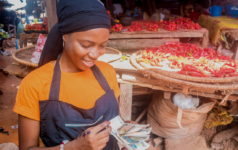Dalberg uses cookies and related technologies to improve the way the site functions. A cookie is a text file that is stored on your device. We use these text files for functionality such as to analyze our traffic or to personalize content. You can easily control how we use cookies on your device by adjusting the settings below, and you may also change those settings at any time by visiting our privacy policy page.
Dalberg and Intel released a new report that shows improving ethnic and gender diversity in the U.S. technology workforce represents a massive economic opportunity, one that could create $470 – $570Bn in new value for the tech industry, and could add 1.2 – 1.6% to national GDP.
Growth on this scale would have major implications for both the labor and consumer markets,

supporting job creation and better products. And yet, the tech industry is not drawing upon the full pool of available talent. While it is no secret that women and racial/ethnic minorities are underrepresented at tech companies—by 19 percentage points for women compared to their presence in the US labor force; by 16 – 18 percentage points for Hispanics, African Americans, and Native Americans—it may come as a surprise to learn how little these figures have changed in the last 15 years.
For technical roles, female representation falls to 12 percent—far short of the proportion of women working in many other occupations traditionally viewed as male-dominated (to name a handful: oil drilling, metal forging, and investment management). Tech leaders recognize this gap and are investing to shrink it, yet racial/ethnic minority representation has only improved by 1 – 2 percentage points over fifteen years, and female representation has fallen by one percentage point. This report offers first-of-its-kind analysis of the economic impact of improving diversity in the tech sector, based on diversity data from nearly 170 companies.
These findings indicate clear correlations – though not necessarily causation – between more diverse tech company workforces and higher revenues, profits, and market value. The data show that every incremental percentage point in African American and Hispanic representation is linked with a three-percentage-point increase in revenues, meaning that the sector could generate an additional $300 – $370Bn each year if the racial/ethnic diversity of tech companies’ workforces reflected that of the talent pool. Similarly, closing the gap in female leadership representation could boost enterprise value by $320 – $390Bn across the sector. This analysis is only now possible because a number of tech companies—including such leading firms as Apple, Yahoo, and Facebook among others—have committed to publicly releasing diversity data.
This analysis is based on regression analyses which use a data set of over 170 tech companies that have published, released, or publicly discussed their top-line diversity figures. The Dalberg research team collected gender and racial/ethnic diversity data on these companies, and then performed regression analysis to understand the relationship between gender diversity, racial diversity and financial success. This analysis controlled for a range of other variables (including employee count and company age) and yielded several statistically significant results. Dalberg applied these results to the domestic technology companies listed on the NASDAQ to estimate the industry-wide effects on revenues, market value, and operating margin. This methodology is detailed in full in the report annex. While correlation does not equal causation, initial indicators are positive and suggest that more research on linkages between performance and diversity in tech is warranted.
Improving diversity in the tech workforce also supports national productivity, with potential growth on the order of 1.2 – 1.6% if the industry can close the gap in representation of women and racial/ethnic minorities.
The technology sector contributes approximately 7% to the nation’s annual GDP, meaning that a surge in tech sector performance would have significant impact on the US economy. Assuming that closing this gap requires at least five years, this equates to an annual 0.2 – 0.3 percentage point boost in national economic growth, over recent average annual growth of 2.2 – 2.4%.
Deeper analysis on the linkages between racial/ethnic diversity and business performance yields several other new insights:
Every incremental percentage point in African American and Hispanic representation is linked with a three-percentage-point increase in revenues at NASDAQ-listed tech companies
Technology companies with racial/ethnic diversity above the median are 14 – 17 percent more likely to generate revenues above industry medians.
Put another way: if two companies are identical in every way except for racial/ethnic diversity and female representation in leadership, the more diverse company will, in all likelihood, have higher revenues, be more profitable, and have a higher market value.
Analysis of the linkage between diversity and financial performance controlled for factors like employee count, years of operation, and depending on the analysis, market cap, revenues, and/or profits (full methodology detailed in annex).
Every one-percentage-point increase in racial/ethnic diversity is linked with a 0.3 – 0.4-percentage-point increase in operating margins. By extension, levels of racial/ethnic diversity that reflect the talent marketplace would be linked with a $6 – 7Bn increase in operating earnings industry-wide.
At small tech companies and startups, diversity’s dividend could also be high:
Small tech companies are, on average, 25 – 30 percent less diverse than large tech companies, but small changes can make a big difference: at a small tech company with $10Mn in annual operating profits, increasing minority representation by five percentage points would be associated an annual profit boost of $1.5 – $2Mn.
The estimated returns to racial/ethnic diversity could add as much as 15 – 20 percent to an early-stage startup’s valuation, providing these companies with a longer runway to test ideas, innovate, and grow.
Beyond effects within the U.S., closing the global tech industry’s female leadership gap could add between 0.5 – 0.6 percent to global GDP. This equates to a $430Bn – $530Bn boost in global productivity, roughly equivalent to a new economy the size of Norway or Taiwan.
Accomplishing this will be a challenge—for example, roughly 60 – 70% of women working in STEM in China, India, and Brazil report experiencing regular sexual harassment (compared to an already disturbing 52% who report such behavior in the United States)—but the payoff could be tremendous.
Bottom line: Advancing diversity in tech is good citizenship, good for business, and good for the national and international marketplace.









